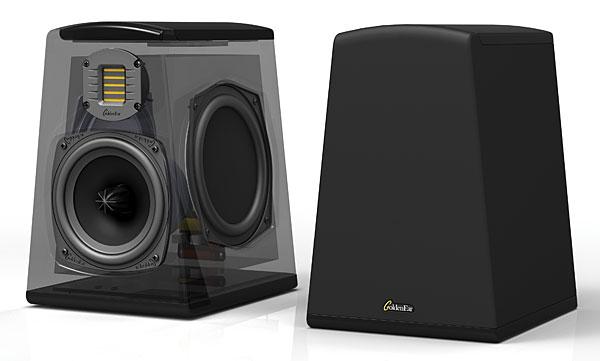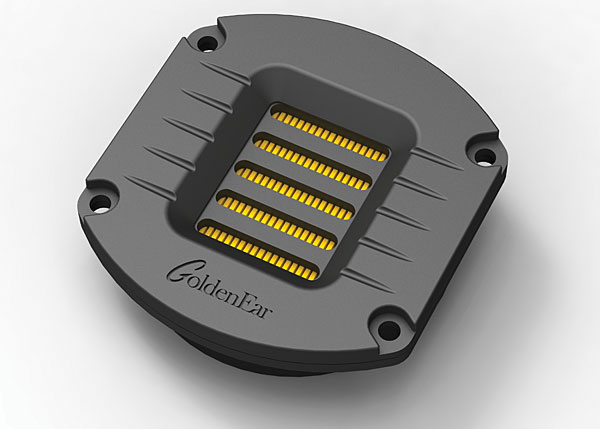| Columns Retired Columns & Blogs |
They look like the head from ZARDOZ.

Back then, in the early 1970s, the stores in our area pushed either Dahlquist DQ-10s or Bose 901s. My epiphany came when Long Island's Audio Breakthroughs announced the new Dahlquist DQ-1W subwoofer to partner with their DQ-10s. Gary and I attended a demo at the store, and I was smitten by the coherent, open, uncolored sound of the DQ-10s with DQ-1W, particularly the way the speakers articulated transients in the midrange. Then I felt a tap on my shoulder, and some guy handed me a crude little metal box. "We're coming out with this soon, which will let you drive the new subwoofer with its own separate amplifier," he said. The metal box was the only prototype of the DQLP-1 crossover, designed by Carl Marchisotto. The guy who'd tapped me on the shoulder was Saul Marantz.
Although it would be five years before I'd have the money and the space for my first Dahlquist-based system, Gary was ready to pull the trigger on a new pair of speakers that night. He ended up with a pair of ESS Laboratories AMT-1s, which featured the Air Motion Transformer ribbon tweeter designed by Dr. Oskar Heil. This tweeter moved air in a semi-perpendicular motion using a folded sheet supported by a series of aluminum struts positioned and immersed in a magnetic field. The diaphragm was expands and contracts in a motion similar to that of an accordion's bellows. Because such a folded tweeter "spits" out air in a way similar to the action of shooting a seed from between one's thumb and forefinger, the tweeters were known in their day as "cherry-pit squeezers."
At the time, Gary and I co-led the Hauppauge Avant-Garde Ensemble, an original jazz-rock and comedy music group. However, as I then owned no serious sound system—I played my records on a General Electric portable, complete with ceramic cartridge—we used his ESS AMT-1s to listen to and analyze our master tapes, and I got to know their sound intimately. I remember that the AMT-1s sounded dynamic, coherent, and uncolored, with crystal-clear, extended highs that had no trace of harshness.
Four decades later, while shopping for a TV for my grad-school roommate at a local audio store—Audio Breakthroughs again—I was taken by the sound coming from a pair of unassuming bookshelf speakers. "What are those?" I asked the owner.
"Oh, those are the GoldenEar Technology Aon 2s. Do you remember the Heil Air Motion ribbon tweeters on the old ESS speakers? The Aons feature a ribbon tweeter that's the direct descendant of that design."
I had to get a pair of Aon 2s in for review.
Design
In addition to its GoldenEar High-Velocity Folded Ribbon Tweeter (HVFR), each Aon 2 has a 6" woofer coupled to two 6.5" low-frequency radiators, one on each side panel. The woofer, too, is designed by GoldenEar, and has a polypropylene cone and a cast "spiderleg" basket with many thin radial struts, to present as little reflective area as possible to the back of the cone. This drive-unit also incorporates a "multi-vaned phase plug" designed to reduce interference near the apex of the radiated cone of energy. The passive radiators load the woofer in a similar manner to a reflex port, and extend the speaker's bass response.

Although the Aon 2's folded-ribbon tweeter is a direct descendent of the Heil driver, it differs in having a diaphragm of high-temperature–tolerant Kapton rather than the Heil's Mylar, and neodymium magnets, which GoldenEar claims makes possible a smaller diaphragm that's also superior in terms of dispersion and low diffraction. The cabinet, a truncated pyramid, was inspired by some of Dick Sequerra's early designs; its nonparallel sides minimize the production of standing waves inside.
I placed the Aon 2s on my 24" Celestion Si stands. Because of the speaker's unusual side-mounted passive drivers, the wraparound grillecloth is not designed to be removed. I listened with the grilles in place.
Listening
I approached this review with a bit of trepidation and some biases. Although I loved the sound of the original Heil tweeter 40 years ago, speaker design has advanced considerably since then. Even as recently as 10 years ago, some audiophiles would choose moving-coil dome tweeters optimized for tonal neutrality, while others opted for the detail, speed, high-frequency extension, and air of ribbons. Nowadays, a well-designed tweeter of any type should be able to accurately reproduce all aspects of every sort of music without compromise. The speakers I've chosen for my reference systems of recent years have had moving-coil tweeters; I've found that today's best moving-coil tweeters combine all the traditional strengths of ribbons and dynamic drivers and none of their weaknesses.
So as I hooked up the GoldenEars to my reference system, I had questions: How well would a modern folded-ribbon tweeter perform in a cost-constrained bookshelf design? Would it be able to articulate detail without adding its own colorations? And, most important, how well would it integrate with the dynamic woofer?
My sensitivities and biases went out the window right away. With all recordings, the Aon 2 revealed extended, detailed, pristine high frequencies with no trace of coloration. Massed violins in Antal Doráti's recording of Stravinsky's The Firebird, with the London Symphony (CD, Mercury SR 90226), and Pétrouchka, with the Minneapolis Symphony (CD, Mercury 434-331-2), were uncolored, with the requisite vibrant bite and shimmering sparkle intact, but with no sharpness or unnatural metallic edge. Jazz trumpets were also quite natural. Every track of Liam Sillery's Outskirts (CD, OA OA2 22050) showcased his trumpet with the same brassy bite I've heard in his live performances. Moreover, the ratios of the upper harmonics of his upper-register tones to their fundamentals were unaltered, and with none of the upper partials truncated.
On the guitar front, Derek Bailey's unorthodox technique on Improvisation (CD, Ampersand Ampere 2) was revealed in as much detail as I've heard with much more expensive speakers. The ringing, plucked harmonics of the upper strings sang, floating on a bed of air with extended and natural decay. And when I listened to "The Deer and Buffalo God Churches," from my jazz quartet Attention Screen's Takes Flight at Yamaha (CD, Stereophile STPH021-2), Don Fiorino's acoustic 11-string guitar, a Seagull flattop, was delicate and detailed—the Aon 2 perfectly captured the instrument's unique twang.
The GoldenEar's integration of the high and midrange frequencies was seamless—I heard no anomalies with instruments that contribute considerable energy near its mid-treble crossover frequency. On pianist Marilyn Crispell's Circles (CD, Victo CD012), there's some tense, dissonant interplay between alto saxophonist Oliver Lake and tenor saxophonist Peter Buettner. Throughout their horns' entire upper registers, I never felt that the players' melodic gymnastics sounded less than completely fluid, integrated, and uniform.

They look like the head from ZARDOZ.

First, I'm thrilled to see someone else has seen the movie Zardoz... and second, that the person had the same reaction I did when seeing the Aons. I had to suppress a snicker the first time I saw the Aon speakers for that reason. Hearing them was amazingly effective in helping me suppress the snicker.
I'm eager to get a pair of Aons for my rear speakers in my video system. I've got Triton Twos for left and right, and a SuperSat 60 center. I tried Supersat 50s for the rear left and right and they didn't have bass needed - the video setup is in a high ceilinged, large family room/dining area location, and without good bass in the rear, the subwoofer up front doesn't integrate well. I'm using a non-Goldenear speaker pair for rear right now, with good bass, and they integrate very well other than the treble isn't as crystaline as it is from the front. So there will be Aon rear speakers in my future - by process of elimination, clearly the right way to go.

I wasn't saying that was a bad thing! But if they start blurting out "THE GUN IS GOOD" then I might be a bit worried.

I don't know many people who care about audio systems, let alone mine. I do know people who care about music.
Went to the University symphony again last night. (They're very good, considering it was a free concert.) Sat row 7, center. Once again I recalibrated, realizing how warm and loud live music is and how much deep bass a symphony produces. Also, surprisingly little imaging or spatial cues. Rather, immense, enveloping physical impact. A lot like good mono classical albums.
I value these recalibrations. Makes me realize the gap between "hi-fi" and live music. Makes me appreciate mono, lush midrange and alarmingly clear bass. (This, of course, doesn't apply to a lot of modern electronic music which is engineered for ultra hi-fiy sounding systems.)
I can't afford and have few people to impress with expensive audio jewelry. So, I value reviews such as this. Good, affordable gear that gets out of the way of real music.
Thanks again, Stereophile.

Has anyone compared GoldenEar Technology Aon 2 to Sjöfn HiFi's "The Clue" speakers (around the same price) or Magnepan Super MMG?
I am particularly interested to know which one delivers more realism.
Thanks

I heard the Aon 2 in two different hi-fi stores and came out disappointed both times.
One retailer hooked these up to SimAudio components. After demoing these, he hooked up Dynaudio Emit 10 and I was blown away by the Dynaudio.
The 2nd time, the retailer played an audio CD from an Oppo player hooked up to a McIntosh stereo receiver. These were dwarfed by the Triton 5, however the margin of victory was too great. It seemed as if Aon 2's were from a different manufacturer altogether.
I think your readers deserve a comparison between the Emit M10 and the Aon 2. In this case, these GoldenEar speakers have received acclaim which they don't deserve, in my humble opinion.
Regardless of your opinion on the Dynaudio, your readers probably deserve to know what you think.
Respectfully yours,
A concerned audiophile